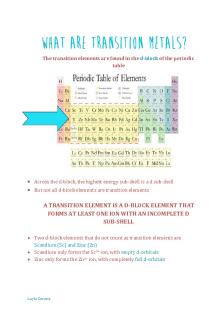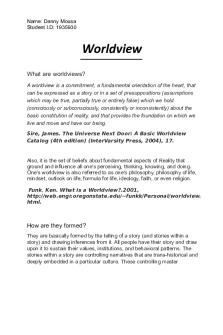Ch 5 Probability What Are the Chance PDF

| Title | Ch 5 Probability What Are the Chance |
|---|---|
| Course | Statistics |
| Institution | University of San Francisco |
| Pages | 2 |
| File Size | 89.1 KB |
| File Type | |
| Total Downloads | 67 |
| Total Views | 171 |
Summary
Download Ch 5 Probability What Are the Chance PDF
Description
Topic: Probability: What Are the Chances? Pd.
Amanda Guillermo
Questions:
Notes:
5.1 Randomness, Probability, and Simulation
- Law of large numbers: if more & more repetition of any chance process observed. Proportion of times a specific outcome occurs approaches a single value 1. Ex: The fact that the proportion of heads in many tosses eventually goes to 0.5 - Probability: probability of any outcome of a chance process is a number between 0 & 1 that describes the proportion of times the outcome would occur in long series of repetition 1. Outcomes that will never occur: 0 2. Outcomes that will always occur: 1 Myths about Randomness - not accurate: predicting outcome based on short run - order only emerges in the long-run - “The idea of probability is that randomness is predictable in the long run” 1. Ex: Which looks more probable? HTHTTH or TTTHHH? - Most will say HTHTTH, but both are equally likely. - Law of averages: the principle that supposes most future events are likely to balance any past deviation from a presumed average.
Table D or TI-nspire TI-nspire: Probability > Random > Integer 1. Lists & Spreadsheet, label L1, L2, Lsum 2. L1 = RandInt (1,6,10) 3. L2 = RandInt (1,6,10) 4. Lsum = L1 + L2 5. Assign L1 & L2 as “variable reference” 6. Produce Lsum
5.2 Probability Rules
Stimulation - stimulation: the imitation of chance behavior, based on a model that accurately reflects the situation - Performing a Simulation: 1. State: What is the question of interest about some chance process? 2. Plan: Describe how to use a chance device to imitate one repetition of the process. Explain clearly how to identify the outcomes of the chance process and what variable to measure. 3. Do: Perform many repetitions of the simulation 4. Conclude: Use the results of your simulation to answer the question of interest
- sample space (denoted as S): a list of all possible outcomes - Ex: 1. Flip coin s = {H,T} 2. Roll 2 dice & record sum: s = {2,3,4,5,6,7,8,9,10,11,12} 3. Roll die then flip coin: s = {1H, 1T, 2H, 2T, 3H, 3T, 4H, 4T, 5H, 5T, 6H, 6T} - event: an outcome or a set of outcomes *an event must be a subset of the entire sample space Basic Rules of Probability 1. Probability of any event is a number between 0 & 1
2. All possible outcomes together must have probabilities whose sum is 1 3. If all outcomes in the sample space are equally likely, the probability that event A occurs can be found using: P(A) = # of outcomes corresponding to event A / total # of outcomes in sample space 4. The probability that an event doesn’t occur is 1 minus the probability that it does occur - Mutually Exclusive (disjoint): two events are mutually exclusive if they have no outcomes in common & so can never occur together Basic Probability Rules: 1. The P(A) of an event satisfies 0 < P(A) < 1 2. If S is the sample space in a probability model, then P(S) = 1 3. The complement of any event A is the event that A does not occur, written as Ac, P(Ac) = 1 - P(A) 4. Two events A&B are mutually exclusive if they have no outcomes in common and so can never occur simultaneously. If A & B are disjoint, P(A or B) = P(A) + P(B)
5.3 Conditional Probability and Independence
- Conditional probability: the probability that one event happens given that another event is already known to have happened Ex: suppose we know that event A has already happened. Then the probability that event B happens given that event A has happened is denoted by P(B|A) - independent (with replacement): if the occurrence of one event has no effect on the chance that the other event will happen 1. Problems WITH replacement: P(B|A) = P(B) - dependent (without replacement): the occurrence of the first event does have an effect on the chance that the other will happen Multiplication Rule - P(A and B) = P(A) x P(B|A) - P(B|A) = P(A and B) / P(A) - independent events: P(A and B) = P(A) x P(B)...
Similar Free PDFs

Chance Ch 9 - Interteaching
- 2 Pages

What are the seven - Grade: 95
- 1 Pages

What are the benefits of OOP
- 4 Pages

What Are Other payables
- 1 Pages

What are transition metals
- 14 Pages

What are worldviews
- 3 Pages

What are conf inter
- 8 Pages
Popular Institutions
- Tinajero National High School - Annex
- Politeknik Caltex Riau
- Yokohama City University
- SGT University
- University of Al-Qadisiyah
- Divine Word College of Vigan
- Techniek College Rotterdam
- Universidade de Santiago
- Universiti Teknologi MARA Cawangan Johor Kampus Pasir Gudang
- Poltekkes Kemenkes Yogyakarta
- Baguio City National High School
- Colegio san marcos
- preparatoria uno
- Centro de Bachillerato Tecnológico Industrial y de Servicios No. 107
- Dalian Maritime University
- Quang Trung Secondary School
- Colegio Tecnológico en Informática
- Corporación Regional de Educación Superior
- Grupo CEDVA
- Dar Al Uloom University
- Centro de Estudios Preuniversitarios de la Universidad Nacional de Ingeniería
- 上智大学
- Aakash International School, Nuna Majara
- San Felipe Neri Catholic School
- Kang Chiao International School - New Taipei City
- Misamis Occidental National High School
- Institución Educativa Escuela Normal Juan Ladrilleros
- Kolehiyo ng Pantukan
- Batanes State College
- Instituto Continental
- Sekolah Menengah Kejuruan Kesehatan Kaltara (Tarakan)
- Colegio de La Inmaculada Concepcion - Cebu








